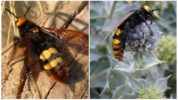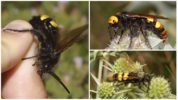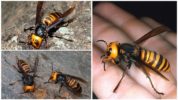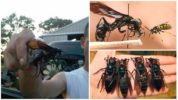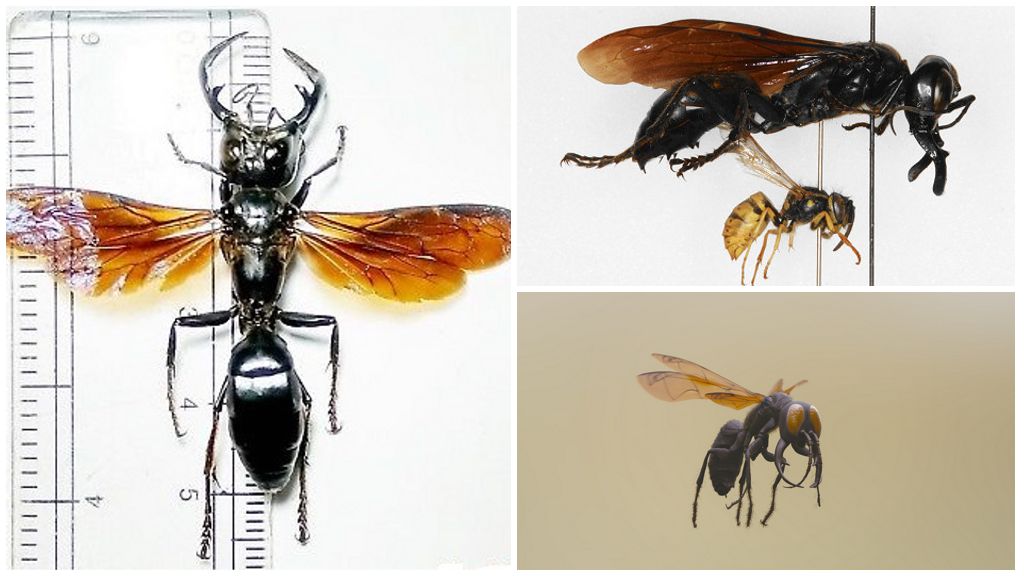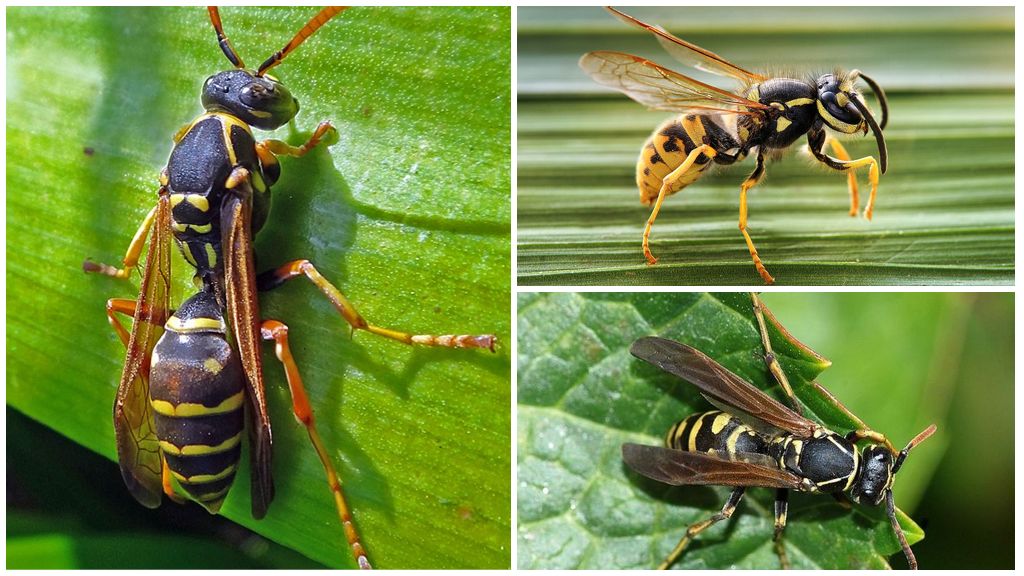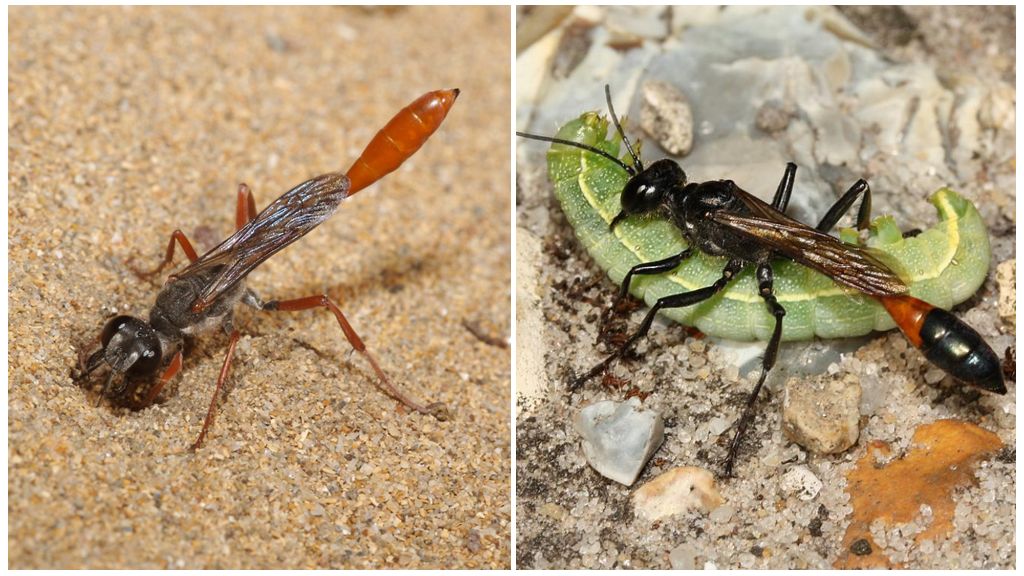- Giant scolia or spotted scolia
- Giant scolia or spotted scolia
- Asian hornet
- Wasp Megalara Garuda
The large wasp, giant or scotch, is the largest species of the entire order of Hymenoptera in Europe. It is listed in the Red Book in Russia, Ukraine. Giant wasps reach a size of 55 mm. The wasp skolii belongs to predators, but is almost not dangerous for humans.
Description of appearance
A large wasp is called a spotted scolia or giant scoli.
- The female size is from 32 to 55 mm, the males are smaller in size - about 32 mm.
- The main color is black. The front part of the sternum is bright yellow. Wide wings with a purple tint.
- The front of the back, the abdomen is covered with small red hairs, the rest of the body - long black.
- The head has a round shape, shiny, yellow. The nape is opaque, black. There are curved antennae on the head, eyes wide apart.
A photo of a large wasp is presented below.
Large Scoli habitat
In the world there are about 1 thousand species of chines. About 25 live in the CIS countries. Three subspecies are distinguished in the world: Megascolia maculata bischoffi, Megascolia maculata flavifrons, Megascolia maculata maculata. The main part of these insects lives in tropical, subtropical zones. A huge wasp lives in North America, Africa, Southern Europe, the Middle East, Turkey, Crimea, Central Asia, and Russia.
The giant scolia lives in forest, forest-steppe, and mountainous areas. Rises in the mountains at an altitude of 1150 m above sea level.
On a note!
The spotted wasp lives in an area where there are large lamellar beetles, because their larvae are needed for laying eggs of the aspen family.
Giant Chole Lifestyle

The largest wasp in the world belongs to primitive creatures, leads a solitary lifestyle. It is active during the day, at night burrows in forest litter, grass. Adults feed on fruit juices, nectar of flowers, however, protein food is required to feed the larvae.
The female lays eggs directly in the victim’s body or feeds the larvae on their own, hunting for large beetles and their offspring - rhinos, some types of gherkins. Attacks the victim, paralyzes poison. In this state, the bug does not die, but is immobilized. This allows you to keep food fresh for a long time. It takes 12 days to eat the bug. As a result, only wings remain from the victim.
In most cases, the female burrows itself into the ground, looks for a larva, stings, lays an egg in the body. After a while, a parasite larva appears, which eats the victim's insides, pupates at the end of its development. In this state, it winters. In spring, a young individual appears. A large wasp is active in May and June.
Interesting!
Unlike public wasps, representatives of large chips do not communicate with each other, do not give each other signs, signals. Insect doesn't build complex nests, and the hunting process is hidden from everyone, because it happens underground. The most famous types of chines are the steppe, giant.
Reproduction of the Great Spotted Scoli
The mating season is limited, as in many species. Young adults mate in May. In June female busy laying eggsgetting food for larvae.By the end of summer, the female is already plotting victims who will become food and a place of development for young offspring.
A fertilized female digs a mink in the ground, drags a paralyzed victim there, lays an egg on her abdomen. It is selected outside, it fills the entrance with earth. Each larva requires a separate hole, its own victim. Further development, growing offspring occurs without the participation of the female.
Interesting!
The larva begins to eat the victim from the least important organs, leaving it alive for a long time. Lastly, the circulatory, nervous system is damaged. At the end of its development, a cocoon weaves, pupates, in this form it remains to winter. In the spring, young females appear, males ready for mating.
Danger to humans, the benefits of a large scale
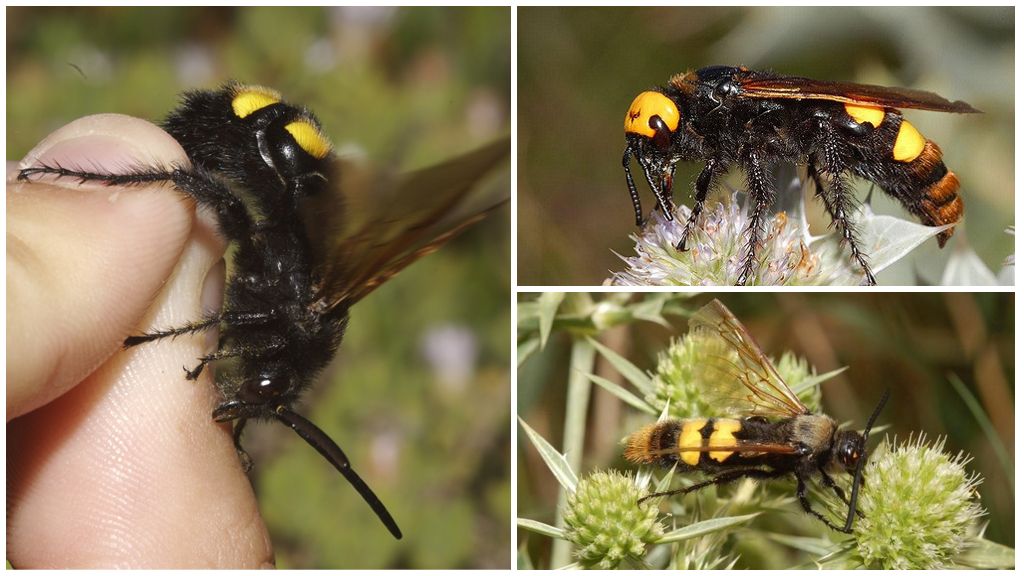
Despite the impressive appearance, the spotted wasp does not pose a particular danger to humans. The insect lives in the wild, does not build nests under the roof of farm buildings, in attics, balconies. Meeting with her is much more difficult than with the usual social wasps.
A large wasp does not have toxic poison, according to the strength of painful sensations, the possibility of development allergic reaction much inferior to social relatives. Unlike them, a large range does not attack with a swarm, because it does not know how to transmit signals.
The nature of spotted chipped peaceable. She prefers not to enter into conflict, but to move away from an unfavorable place. He does not pay attention to too annoying offenders, continues to do his own thing.
Collecting nectar, large chines are actively involved in the pollination of certain plant species. Doubtless favor they bring, destroying the larvae of beetles that spoil horticultural crops, trees. Many landowners are not at all opposed to the giant chippy living on its territory, and some specifically bring females to their lands.
Other types of large wasps
Spotted scolia is the most beautiful representative of large insects. But there are giants in whom external unattractiveness is combined with danger and aggressiveness.
Asian hornet
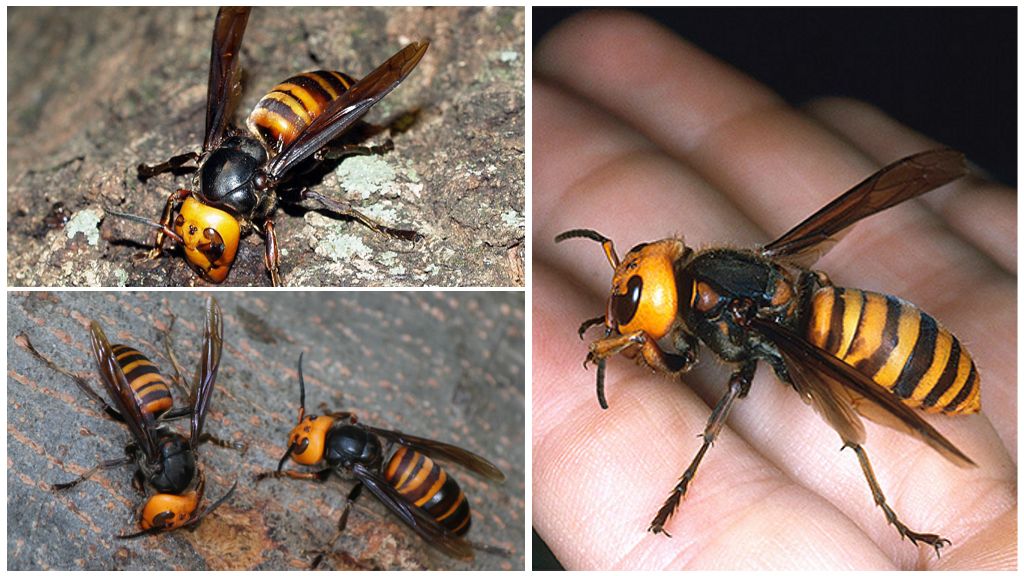
The largest wasp in the world impresses with its size, behavior, and the strength of the poison. According to official figures, in Japan and China, 50 people die every year from the bite of a giant wasp. We are talking about Asian hornet Vespamandariniathat relates to the genus real wasps. The size reaches 6 cm in length, the wingspan is 7.5 cm. The body color of a hefty insect is black and yellow.
Giant wasps live in forests, near ponds. Relate to public wasps. The head of the genus is the female uterus. It lays the foundation for the future aspen nest. Huge insects build hives with the whole family. The finished structure reaches 80 cm in width, 50 cm in diameter.
Working individuals to provide larvae with food, to satisfy their hunger, make frequent raids on bee hives. Honey, nectar is eaten, paralyzed bees are carried in the comb for feeding young.
On a note!
Many tourists, seeing a huge wasp, are trying to consider or photograph it. The insect perceives this as aggression, rushes to attack. A bite is comparable to piercing a skin with a hot nail. The poison is extremely toxic, but the fact that the aggressor pulls out the sting and spends the poison saves it. In one bite, injects about 2 mg of a toxic substance.
Large wasps are dangerous for humans with a strong allergic reaction, a general deterioration in well-being. There is swelling, redness, rash, pain, decreased blood pressure, headache, signs of intoxication, breathing problems, cramps. The situation is complicated if the wasp attacked several times or there were several individuals.
Megalara Garuda
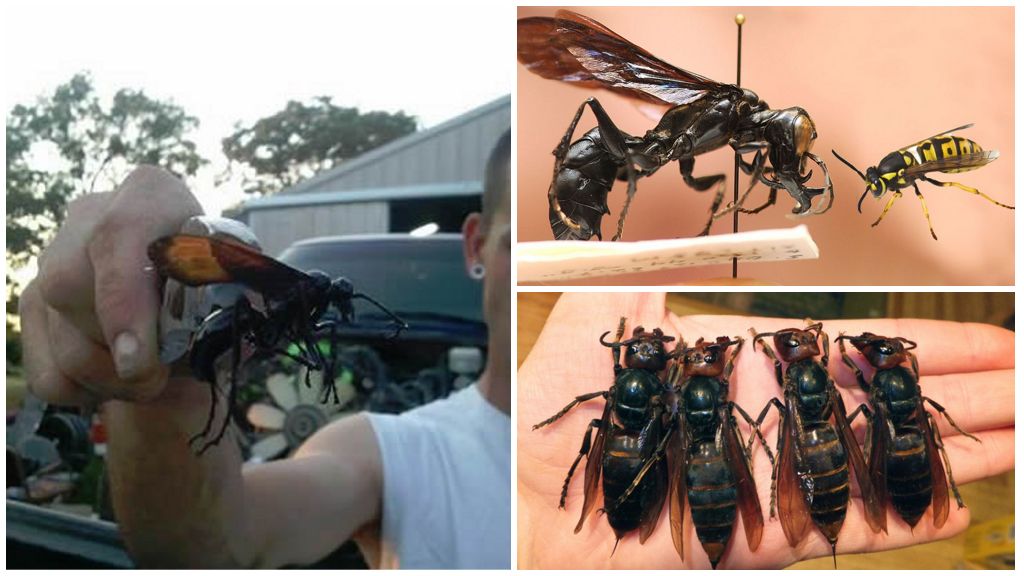
A new species of large wasps was discovered in Indonesia, officially introduced in 2012. The body size of the male is about 32 mm, the female grows to almost 5 cm.Powerful jaws, long whiskers, significantly distinguish from the aspen family of this enormous representative. Due to the terrifying appearance of the megalar garuda, the locals gave the name Komodo lizard. Belongs to the genus of sand wasps, is a predator because it eats other insects. Some sources call this species the largest wasp in the world.
